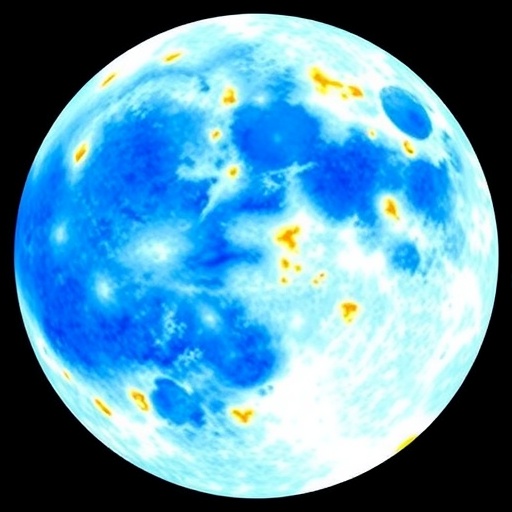In a groundbreaking study poised to redefine our understanding of the Moon’s geological history, researchers have unveiled comprehensive global maps detailing the chemical composition and distribution of oxides across the lunar surface. This monumental work, led by Qiu, Yan, and Liu, is encapsulated in their recent publication in Commun Earth Environ and opens up new avenues for lunar science, exploration, and even the potential for future colonization of our nearest celestial neighbor.
The Moon, Earth’s only natural satellite, has been a focal point for both scientific inquiry and human exploration. For centuries, its surface has been studied through telescopes and landers, yet many of its chemical constituents remain inadequately understood. This new research presents a significant advance, providing high-resolution maps that showcase where various oxides, such as silicon dioxide, titanium dioxide, and iron oxides, exist in abundance. Such information is crucial for future lunar missions, as these materials could be utilized for construction and resource extraction.
Lunar surface compositions are largely dictated by the geological processes that have shaped the Moon over billions of years. The study’s authors applied advanced computational techniques to analyze data collected from various lunar missions, including those conducted by NASA and the European Space Agency. By leveraging this wealth of data, they created intricate chemical composition maps that not only illustrate the distribution of oxides but also provide insights into the Moon’s volcanic activity and impact cratering history.
The findings indicate that the distribution of oxides is not random but instead reflects a tapestry of geological processes that have occurred over time. For instance, areas rich in titanium oxides are often associated with ancient volcanic activity, suggesting that these regions may have been hotspots of igneous processes. Conversely, regions with a prevalence of iron oxides indicate impacts from celestial bodies that have added to the Moon’s surface diversity. Such insights are invaluable for understanding the Moon’s evolution and its similarities and differences compared to Earth.
Moreover, the maps generated by the team allow for the identification of potential sites for future exploration. For example, areas with high concentrations of useful oxides may serve as prime targets for missions aimed at in-situ resource utilization (ISRU). This practice, which refers to using lunar materials to support human activities, could be a game-changer for the sustainability of long-term lunar missions.
The technological innovation employed in this study is also noteworthy. The research team utilized machine learning algorithms that can discern complex patterns in the enormous datasets obtained from remote sensing instruments. This approach not only enhanced the accuracy of oxide distribution maps but also set a precedent for future studies in planetary science. The ability to swiftly analyze and interpret large sets of data will undeniably facilitate deeper investigations into not just the Moon, but other celestial bodies as well.
Additionally, these maps serve as a baseline for comparing lunar chemical compositions with that of other bodies in the solar system. Understanding how the Moon’s surface composition diverges from that of Mars or asteroids will help scientists make sense of the processes that govern planetary differentiation and surface evolution. This comparative analysis is essential for piecing together the broader narrative of our solar system’s history.
The significance of this research extends beyond merely added scientific knowledge; it has implications for potential commercial interests as well. As nations and private industries set their sights on exploiting extraterrestrial resources, understanding the chemical composition of the lunar surface becomes paramount. The economic potential of mining lunar resources could transform space exploration, making previously unfeasible ideas, such as establishing permanent lunar bases, more plausible.
Moreover, these findings play into the growing discourse surrounding the sustainable exploration of space. With an increasing number of spacefaring entities, including private companies and multiple national agencies, the idea of shared knowledge and collaboration becomes vital. The maps produced by this research provide a valuable tool not just for individual missions but for the international community aiming to work cooperatively towards sustainable lunar exploration.
As scientists further analyze these maps, their implications will likely resonate through various disciplines, from geology to astrobiology. By revealing the Moon’s mineral wealth, researchers have opened new doors to investigate the potential for life, as mineral-rich environments are often indicators of habitability. While the Moon may not appear hospitable at first glance, this research suggests that it certainly has the materials necessary to support human and perhaps even microbial life.
As we move towards a future where lunar exploration is a near certainty, such detailed chemical composition maps are not only useful—they are essential. They empower exploration missions with data-driven strategies, making it feasible for astronauts to identify locations where they can find water, oxygen, and other vital resources.
In conclusion, the publication of global chemical composition maps marking the distribution of oxides on the lunar surface heralds a transformative stride in our understanding of the Moon. This research stands at the intersection of curiosity and utility, marrying scientific advancement with practical applications. As humanity’s vision of settling on the Moon inches closer to reality, the work undertaken by Qiu, Yan, and Liu serves as a beacon of innovation and rationale in the quest for knowledge beyond our terrestrial bounds.
Subject of Research: Lunar surface chemical composition and oxide distribution.
Article Title: Global chemical composition maps of oxide distributions on the Lunar surface.
Article References:
Qiu, D., Yan, J. & Liu, B. Global chemical composition maps of oxide distributions on the Lunar surface.
Commun Earth Environ 6, 940 (2025). https://doi.org/10.1038/s43247-025-02914-w
Image Credits: AI Generated
DOI: https://doi.org/10.1038/s43247-025-02914-w
Keywords: Lunar Exploration, Chemical Composition, Oxide Distribution, Planetary Science, Resources, Machine Learning, In-Situ Resource Utilization, Sustainable Exploration.




